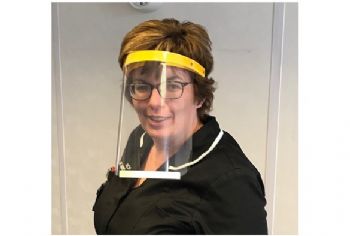
Engineers at the University of Liverpool have begun using their expertise in 3-D printing and laser cutting technologies to produce protective visors for use by local hospitals.
The protective visors, developed in conjunction with NHS staff at local hospitals (including the Royal Liverpool University Hospital, Broadgreen Hospital, Aintree University Hospital and Southport & Orrmskirk Hospital Trust), use a hybrid design approach with a laser cut top section and a 3-D printed bottom section.
Laser cutting technology reduces the production process significantly from 6hr to 30min and local industry are helping to scale up production further.
Staff and PhD students, based in the University’s Active Learning Laboratory, are using their technical facilities and expertise to produce an initial batch of 50 to 100 protective visors per day, with the intention of ramping this up to manufacture hundreds per day over the coming weeks.
The initial batch of protective visors have been delivered to three hospitals in the local region with other local hospitals soon to receive supplies.
Dr Kate Black, an expert in additive manufacturing at the University of Liverpool, said: “Thanks to 3-D printing and laser cutting technology, our team of engineers have been able to design a protective visor that can be produced in about 30min.
“We have worked closely with our local NHS hospitals on the design and now that they are happy with it our dedicated team of staff and PhD students from the university are ready to start production so that we can help protect our health services staff at this time of extraordinary need.”
Dr Paul Fitzsimmons, deputy medical director at Liverpool University Hospitals NHS Foundation Trust said: “I’d like to thank Dr Black and her team for all their amazing work in designing and producing these visors and not only getting them to our hospitals so quickly, but for sharing the information required to make them with colleagues across the UK and help hospitals access more of the equipment they need in the fight against coronavirus.”
Professor Louise Kenny, executive pro vice chancellor of the University of Liverpool’s Faculty of Health and Life Sciences, said: “The COVID-19 pandemic presents an unprecedented global challenge, and staff and students across our faculties and departments here at the University of Liverpool are coming together in all sorts of ways to provide their expertise, facilities and innovation to manage, mitigate, and eventually stop this virus.”